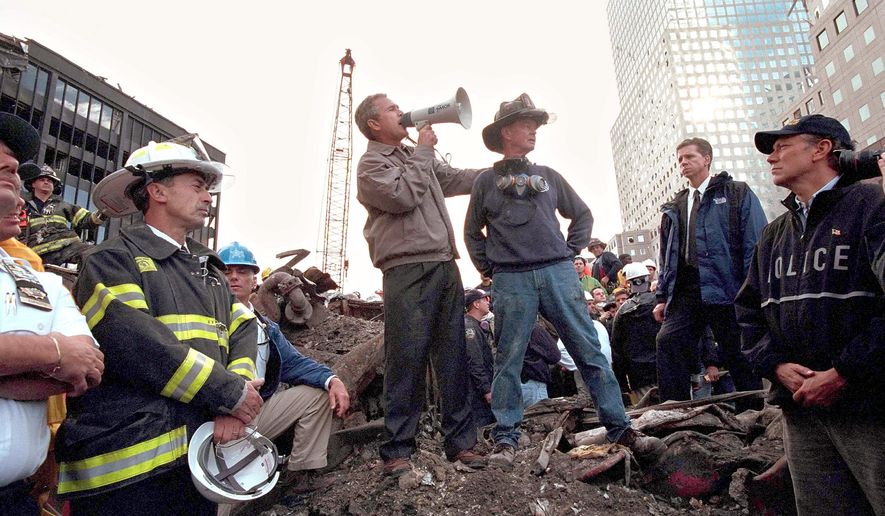On Sept. 14, 2001, George W. Bush was standing with New York City firefighters in the rubble of the World Trade Center, trying to address a crowd, when someone shouted that he couldn’t hear what the president was saying.
“I can hear you,” Mr. Bush said through a bullhorn. “The rest of the world hears you. And the people who knocked these buildings down will hear all of us soon.”
The war on terrorism had begun.
The al Qaeda terrorist network, headed by Osama bin Laden, claimed responsibility for the Sept. 11 attacks, in which radical Islamic terrorists hijacked four U.S. jetliners and flew them into the twin towers of the World Trade Center and the Pentagon. Passengers of one jetliner overpowered the hijackers and crashed the plane into a field in Pennsylvania. More than 3,000 people were killed in the attacks.
Afghanistan, ruled by the Islamic totalitarian Taliban regime, had been sheltering al Qaeda and bin Laden and refused to deliver them to Western authorities. The U.S. assembled a multinational force and in October 2001 began bombing raids and eventually invaded Afghanistan. The Taliban were toppled quickly, but their leaders and bin Laden escaped.
In the wake of Operation Enduring Freedom, a democratic government was established in Afghanistan.
Meanwhile, the U.S. response to the terrorist threat included the enactment of the Patriot Act and the establishment of the Department of Homeland Security.
Mr. Bush then turned his eyes toward Iraq. Citing intelligence reports, he and other administration leaders said Iraqi President Saddam Hussein had acquired weapons of mass destruction and the means to deliver them.
In 2002, the Senate authorized the president to use force against Iraq. In March 2003, U.S. forces launched strikes against Saddam’s regime. Within weeks, Baghdad fell, Saddam was deposed and Mr. Bush declared an end to major combat operations underneath a “Mission Accomplished” banner on board an aircraft carrier returning from the Persian Gulf.
But insurgents from nearby countries and Saddam loyalists began thwarting efforts to establish a democratic government in Iraq. Shiites began seeking revenge against the Sunni minority that had oppressed them under Saddam. Al Qaeda set up operations in the country, and sectarian violence threatened to escalate into all-out civil war.
It was only after a much-derided “surge” in U.S. forces ordered by Mr. Bush in 2007 that the situation was stabilized and the government in Baghdad was able to re-establish control over the country.
President Obama, promising to reverse the policies of his predecessor, ended the combat mission in Iraq and tried to wind down operations in Afghanistan, scoring a major intelligence and security coup with the successful mission to assassinate bin Laden in his Pakistan hideout in May 2011.
But Mr. Obama’s policy of strategic retreat ran into problems on multiple fronts when a new civil war broke out in Syria, Russia seized the Crimean Peninsula from the Western-backed government in Ukraine, the Taliban stepped up its resistance to the U.S.-backed government in Afghanistan and, most crucially, a new movement calling itself the Islamic State arose from the remnants of the radical resistance to the government in Iraq.
After Syria defied Mr. Obama’s “red line” against chemical weapons use, Russia and Iran provided new military muscle for Syrian leader Bashar Assad to keep him in power. Islamic State exploited a power vacuum to seize broad swaths of Syria and Iraq, attracting foreign fighters from around the world to its self-proclaimed “caliphate” in the heart of the Middle East in 2015.
The U.S. and its military have only slowly clawed back territory from the deadly ISIS movement, a campaign that has gathered strength under President Trump in pitched battles to reclaim cities such as Mosul in Iraq and Raqqa in Syria. Mr. Trump has also approved more U.S. forces for Afghanistan, although there is little sign of a quick end to a 16-year conflict that now rates as the longest in U.S. history.
The global war on terror, first proclaimed by Mr. Bush, shows no signs of winding down anytime soon.
Throughout the string of conflicts that have marked the new millennium, The Washington Times has provided exclusive reports on policies, plans and programs, covering the Pentagon, the White House and Capitol Hill, as well as events in Afghanistan and Iraq.




Please read our comment policy before commenting.